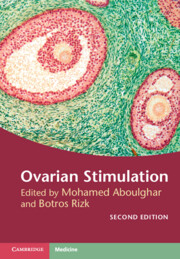Book contents
- Ovarian Stimulation
- Ovarian Stimulation
- Copyright page
- Dedication
- Contents
- Contributors
- About the Editors
- Foreword
- Preface to the first edition
- Preface to the second edition
- Section 1 Mild Forms of Ovarian Stimulation
- Section 2 Ovarian Hyperstimulation for IVF
- Section 3 Difficulties and Complications of Ovarian Stimulation and Implantation
- Section 4 Non-conventional Forms Used during Ovarian Stimulation
- Section 5 Alternatives to Ovarian Hyperstimulation and Delayed Transfer
- Section 6 Procedures before, during, and after Ovarian Stimulation
- Chapter 26 Ultrasound Monitoring for Ovulation Induction: Pitfalls and Problems
- Chapter 27 The Use of GnRH Agonists to Trigger Final Oocyte Maturation during Controlled Ovarian Stimulation
- Chapter 28 The Luteal Phase Support in In Vitro Fertilization
- Chapter 29 Luteal Phase Support Other than Progesterone
- Chapter 30 Ovarian Reserve as a Guide for Ovarian Stimulation
- Index
- References
Chapter 26 - Ultrasound Monitoring for Ovulation Induction: Pitfalls and Problems
from Section 6 - Procedures before, during, and after Ovarian Stimulation
Published online by Cambridge University Press: 14 April 2022
- Ovarian Stimulation
- Ovarian Stimulation
- Copyright page
- Dedication
- Contents
- Contributors
- About the Editors
- Foreword
- Preface to the first edition
- Preface to the second edition
- Section 1 Mild Forms of Ovarian Stimulation
- Section 2 Ovarian Hyperstimulation for IVF
- Section 3 Difficulties and Complications of Ovarian Stimulation and Implantation
- Section 4 Non-conventional Forms Used during Ovarian Stimulation
- Section 5 Alternatives to Ovarian Hyperstimulation and Delayed Transfer
- Section 6 Procedures before, during, and after Ovarian Stimulation
- Chapter 26 Ultrasound Monitoring for Ovulation Induction: Pitfalls and Problems
- Chapter 27 The Use of GnRH Agonists to Trigger Final Oocyte Maturation during Controlled Ovarian Stimulation
- Chapter 28 The Luteal Phase Support in In Vitro Fertilization
- Chapter 29 Luteal Phase Support Other than Progesterone
- Chapter 30 Ovarian Reserve as a Guide for Ovarian Stimulation
- Index
- References
Summary
Ovulation induction using stimulation drugs has now been in practice for over 40 years. Until the introduction of ultrasound, monitoring of follicular growth was a difficult task. Transvaginal ultrasound is now the routine for ovulation induction monitoring. Transvaginal probes have a much higher frequency reaching 4–9 MHz, and have wider angles up to 180º and depths that could reach 16 cm, facilitating the procedure of monitoring.
- Type
- Chapter
- Information
- Ovarian Stimulation , pp. 265 - 281Publisher: Cambridge University PressPrint publication year: 2022



